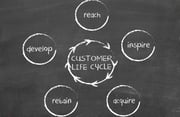3 Ways to Track Your Key Customers’ Goals
in Voice of Customer, Key Account Management /Key account managers should always consider customer goals ahead of internal business concerns. Too often, the goals of key accounts get pushed aside or forgotten in the frenzy of day-to-day business operations that are designed to support the goals of the company itself—landing new accounts, creating or handling a product, or maintaining promptness and quality.
While the company’s goals are important, it is critical to keep foremost in mind the goals and expectations of the customer and to maintain alignment with the customer’s goals during day-to-day processes. Following are some suggestions for tracking customer goals, creating an infrastructure for focusing on those goals, and evaluating key customer responses.
Tracking Customer Goals
Tracking customer goals is essential to understanding how to accomplish them, but first you have to know what those goals are.
The best place to start is by simply asking your customers what they’re looking to accomplish through your relationship. One way you can do this is by having each of your key customers fill out a goal-oriented questionnaire, enumerating and prioritizing what they are looking for throughout each of the various stages of your interaction. At Kapta, we call this Voice of Customer, and it’s an extremely powerful way to align with your clients.
Above all, it’s important to constantly update and revisit these goals with your customer. Maintain regular communication, and take time to discuss how goals are evolving and changing.
Creating an Infrastructure for Reaching Goals
Next comes crafting a business infrastructure that places your customers’ goals in clear focus for your key account management team. For key account managers in particular, this infrastructure is critical to maintaining mutually beneficial and long-lasting relationships with your most valuable accounts.
According to CustomerThink.com, there are numerous approaches to accomplishing this. One approach is to personalize the customer experience as much as possible. That is, once you have learned a customer’s habits and priorities, create a persona that represents that company and design strategies that cater to that persona, incorporating the details that are critical to that specific persona’s development. For example, you might have a customer for whom speedy delivery is a top priority, and for whom you might create the “speedy” persona to ensure that every part of the interaction process functions toward timely and accurate delivery of the product or service. This makes the customer’s goals clearer and provides a path to achieving them.
Another approach is to outline the phases of the interaction process between your company and the key account, and to identify checkpoints within each of those phases. Examples of such phases might be product ordering, assembly of product, and delivery. Allowing the customer to check in with you, identifying his or her goals as each phase comes up, can be a great way to make sure your key account management team is consistently working toward the customer’s goals.
While doing this, it is important to maintain an effective internal communication system within your company, allowing those who contribute to each phase to interact with key account managers in order to keep the customers’ goals in sight.
Evaluating Customer Satisfaction
Finally, evaluating your customers’ experience is essential to understanding and carrying out your customers’ goals. This is important because it is necessary to gain an in-depth understand of how your customers feel about your relationship, in order to plan for future success.
Measure the satisfaction of your key accounts by, again, having them fill out a questionnaire that asks about how they felt about your service or product. Did you play an active and supportive role in helping them to achieve a goal? Were their expectations met or exceeded? Did your service provide the kind of value they expected? Here, it is important to understand and include your customer’s emotional reactions at each phase of your interaction with the customer.
Often it is best to ask for feedback in a way that is convenient and comfortable for the customer. They may not feel comfortable telling you in person that you’re not meeting their expectations in some way, but may be more willing to open up through an online survey or email exchange.
Understanding the goals and needs of your key accounts is crucial to growing profitable, long-term relationships with them. By implementing these simple account-based goal measuring processes, you can improve your relationships with your customers and ensure you’re focusing your attention on their needs.







